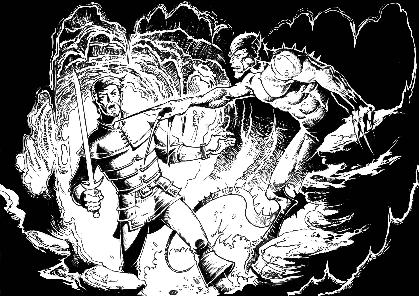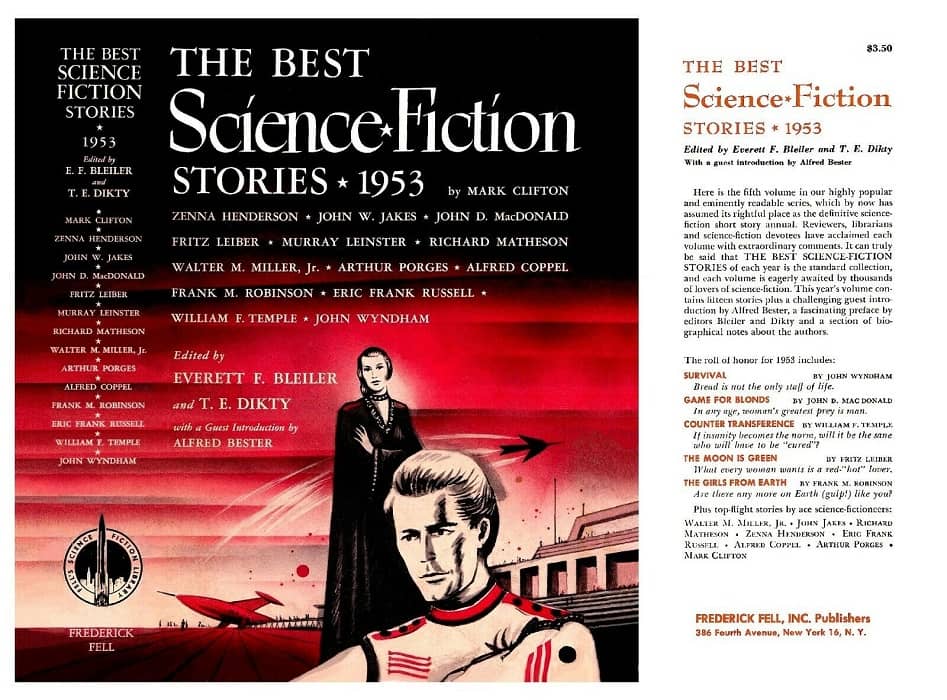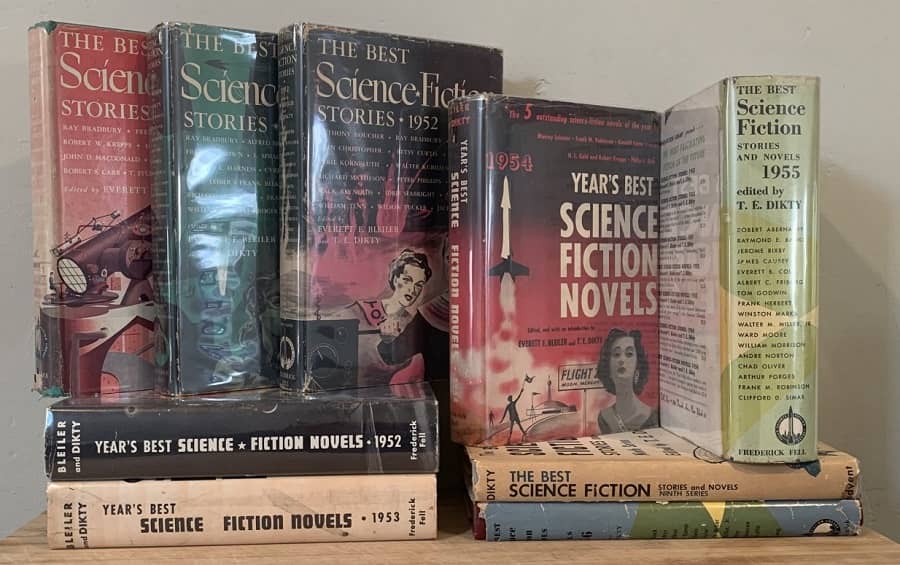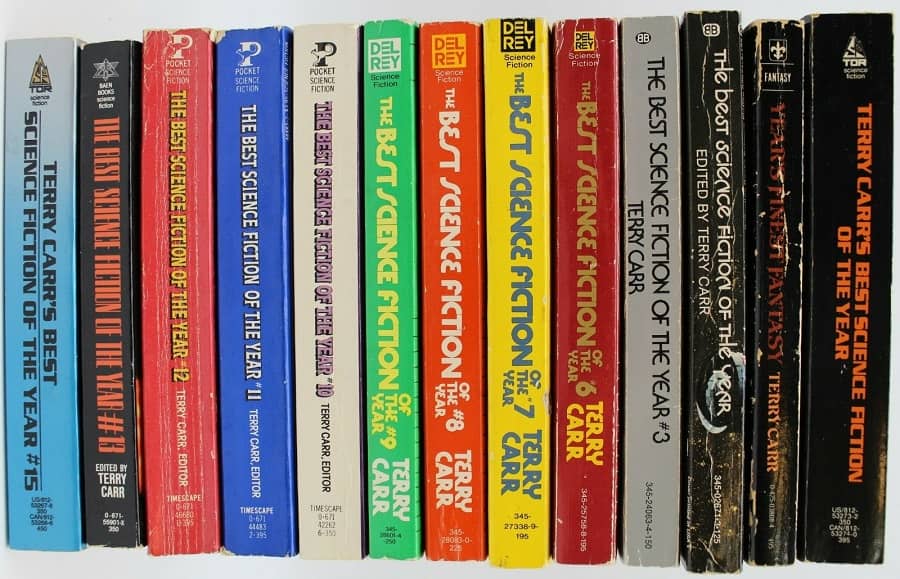Science Fiction is a Small Community
The Best Science Fiction Stories: 1953, edited by Everett F. Bleiler and T. E. Dikty (Frederick Fell, 1953). Cover art uncredited.
Two weeks ago I bought a handsome copy of The Best Science Fiction Stories: 1953, edited by Everett F. Bleiler and T. E. Dikty, from a seller on eBay. As I carefully opened the package, I noticed the return address said “Stephen E. Fabian.”
Huh. Like, Stephan Fabian, the artist? Naturally I did what any of you would have done. I dashed off a quick message to the seller, and in due course I received this friendly response:
Yes, I am Stephen E. Fabian, the artist, though I’ve been semi-retired since way back in 1992. Thanks for asking. Stay safe, Steve
Well, that was cool. Fabian, of course, is one of the most talented artists to ever work in the field of SF and fantasy. We’ve covered his work here many times, and you can see some of his gorgeous pen & ink work here.
But that brief exchange reminded me (as if I needed reminding) that the science fiction community is a small one, and you never know who you’re going to run into. It reminded me of that day I ran into Fred Pohl on the street in downtown Chicago, and the week I discovered that the Bill Johnson I’d been working with at Motorola for years was the same one who won a Hugo Award for “We Will Drink a Fish Together.”
The highly collectible Year’s Best volumes of Bleiler and Dikty (Frederick Fell, 1949-56)
Coincidences like that sure make life interesting. I invited Bill out to grab something to eat, and that became the first of many lunch time discussions we had. I’ve had many memorable conversations over lunch in my career, but I’ve never had another lunch companion as fascinating as Bill. I’ll never forget that time we huddled together over spicy noodles at Yu’s Manderin in Schaumberg, and Bill entertained me for nearly an hour with his plans for an epic SF tale set inside a torus-shaped black hole.
Eventually I bought a wonderful virtual-reality tale from Bill, “Mama Told Me Not to Come,” that appeared in Black Gate 4.

Artwork for “Mama Told me Not to Come” by Chris Pepper
Anyway, I’m thoroughly enjoying The Best Science Fiction Stories: 1953. Everett F. Bleiler and T. E. Dikty were the first to publish a science fiction year’s best series. Their books were highly regarded, and were published in hardcover by Frederick Fell from 1949-1956. Sadly, they were never reprinted in paperback.
In a very real way Bleiler and Dikty pioneered the Year’s Best anthologies later emulated by Donald Wollheim, Terry Carr, Gardner Dozois, and others, and today by Jonathan Strahan, Rich Horton, Neil Clarke, and others. They proved that demand existed for these books, and for many of the authors they reprinted it was their first experience in a hardcover edition.
Some of the Year’s Best volumes edited by Terry Carr in the 70s and 80s
Reading the Editors’ Preface for The Best Science-Fiction Stories: 1953, and the introduction by Alfred Bester, “Trematode, a Critique of Modern Science-Fiction,” reminds me very much of an era when science fiction was much smaller than it is today, and the dedicated reader could take in all there was to know of the field.
That isn’t possible today of course — and it hasn’t been for many decades. But as long as I can buy books from Stephan Fabian, and have long and lively lunches with fellow science fiction writers (even if they’re virtual), then I continue to nurture the belief that Science Fiction remains a small and friendly community. I hope you do too.
The Best Science Fiction Stories: 1953 contains a People story by Zenna Henderson, the horror classic “The Fly” by Arthur Porges, and stories by John Jakes, Murray Leinster, Fritz Leiber, Walter M. Miller, Jr., John Wyndham, John D. MacDonald, Richard Matheson, Alfred Coppel — and two tales by Eric Frank Russell. Here’s the complete table of contents.
Editors’ Preface by Everett F. Bleiler and T. E. Dikty
Trematode, a Critique of Modern Science-Fiction, by Alfred Bester
“The Fly” by Arthur Porges (The Magazine of Fantasy and Science Fiction, September 1952)
“Ararat” by Zenna Henderson (The Magazine of Fantasy and Science Fiction, October 1952)
“Counter-Transference” by William F. Temple (Thrilling Wonder Stories, April 1952)
“The Conqueror” by Mark Clifton (Astounding Science Fiction, August 1952)
“Machine” by John Jakes (The Magazine of Fantasy and Science Fiction, April 1952)
“The Middle of the Week After Next” by Murray Leinster (Thrilling Wonder Stories, August 1952)
“The Dreamer” by Alfred Coppel (The Magazine of Fantasy and Science Fiction, April 1952)
“The Moon Is Green” by Fritz Leiber (Galaxy Science Fiction, April 1952)
“I Am Nothing” by Eric Frank Russell (Astounding Science Fiction, July 1952)
“Command Performance” by Walter M. Miller, Jr. (Galaxy Science Fiction, November 1952)
“Survival” by John Wyndham (Thrilling Wonder Stories, February 1952)
“Game for Blondes” by John D. MacDonald (Galaxy Science Fiction, October 1952)
“The Girls from Earth” by Frank M. Robinson (Galaxy Science Fiction, January 1952)
“Lover, When You’re Near Me” by Richard Matheson (Galaxy Science Fiction, May 1952)
“Fast Falls the Eventide” by Eric Frank Russell (Astounding Science Fiction, May 1952)
About the Authors
I bought my copy of The Best Science Fiction Stories: 1953 (from Stephen Fabian!) on eBay for $49.75. It was originally published by Frederick Fell in September 1953. It is 279 pages, priced at $3.50. It has never been reprinted in the US, and there is no paperback or digital edition. The cover artist is uncredited.
See all my recent Editor’s Blog articles here.



I didn’t know you had worked with Bill Johnson! Cool!
I loved Fabian’s work back in the ’70s.
The Schaumburg offices of Motorola in the 90s was a pretty cool place. I met Dave Kenzer there (owner of KenzerCo, publisher of the KNIGHTS OF THE DINNER TABLE comic), Bill Johnson, and others.
Dave in particular was absolutely critical in helping me get Black Gate started — including investing $10,000 seed capital, introducing me to his printer, distributing the mag to game stores, and guiding me around a ton of newbie errors.
But Bill was also hugely supportive. He’s such a supportive guy in general, and loves to discuss SF. I really enjoyed our occasional lunches.
In the late 90s Bill had an aortic dissection — a horrific arterial rupture that has only a 15% survival rate — and was forced to semi-retire. I haven’t seen him in nearly 20 years, though we still chat on Facebook.
I’ve loved Fabian’s work for a long time. Didn’t realize he had been absent from the scene for so long.
I too loved Fabian’s work – some of his stuff had a very Virgil Finlay kind of vibe to it.
I admit the price on the Best SF of 1953 would have given me pause, but then I’d no memory of the volume (I was 8 at the time), or its predecessors. Damn shame they weren’t reprinted. Nice find, John, very nice.
Thomas — yes, definite Virgil Finlay vibe to some of Fabian’s work.
John — I remember hearing about Bill Johnson’s aortic dissection. It seems like he couldn’t write for a while after that, but he’s had some pretty good stories in Analog in recent years. Alas, I assume the epic space adventure inside the lotus shaped black hole might never happen, though!
> I’ve loved Fabian’s work for a long time. Didn’t realize he had been absent from the scene for so long.
John,
You weren’t the only one! Stephen Fabian was one of the first artists I approached to commission a cover for Black Gate, almost exactly 20 years ago. He let me know he was no longer painting, but he was open to selling reprint rights. I haunted his website for many long months, looking at the covers he featured:
https://www.stephenfabian.com/gallery
Eventually of course, we went with all-original art at Black Gate (with the exception of the first-US rights we bought for two paintings by Bruce Pennington, which originally appeared on British paperbacks). But I’m still disappointed we were never able to showcase Fabian on a cover.
> I too loved Fabian’s work – some of his stuff had a very Virgil Finlay kind of vibe to it.
Thomas,
You know, I never made the connection before, but looking over his gallery again, you’re absolutely right.
> I admit the price on the Best SF of 1953 would have given me pause… Nice find, John, very nice.
RK,
Well, I have most of the others, and you always pay more to get the last few in a set. 🙂
Besides, it is in SUCH beautiful shape. $49.75 doesn’t seem like all that much to pay for a nearly-perfect copy of a 70-year old hardcover. Not much more than some of the hardcovers I buy today!
A lot of great stuff on that website, John.